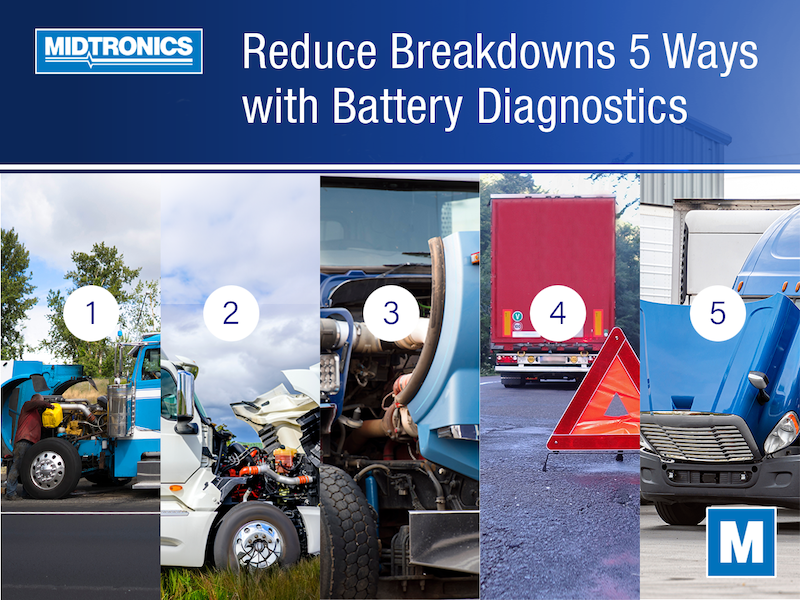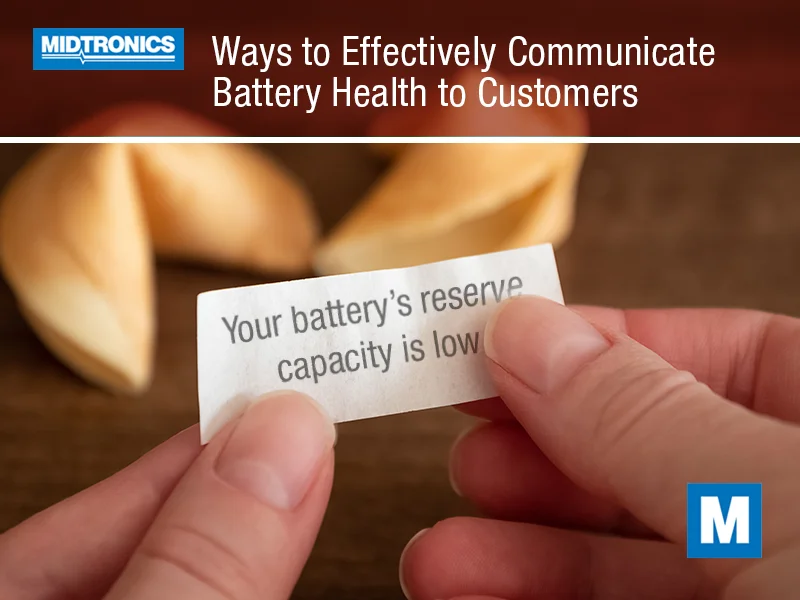It takes a lot of time and effort to make sure fleet vehicles stay on the road as much as possible. For every day – or even every hour – of downtime, it costs your business. It could be the wages of a long-haul driver who’s sidelined with a dead battery, a rental car that can’t be rented out because it won’t start, or any number of other scenarios.
And it comes with more expenses too. If a breakdown happens away from home base, there are additional repair costs from a shop that doesn’t have negotiated rates, parts costs are higher, and there can be roadside or towing-related charges too.
Cost, inconveniences, and downtime can be avoided for battery issues, though, with these five battery diagnostic processes.
Test Batteries During Every Service Interval
For fleets of all sizes, service intervals are often required at much shorter time intervals than the typical personal vehicle, although it’s due to more idling time on the engine and miles accumulated from more time on the road. Because of the frequency that tire rotations, oil changes, brake replacements, and other routine services are required, battery tests might not be done on each of these visits to the shop.
However, it’s leaving your vehicle at risk of a battery issue. How will you know when a battery test has been performed last, and when should it be done next? Since a battery test as part of preventative maintenance only takes around a minute, there’s no reason not to do it on every service. And because a battery can deteriorate quickly under the harsh conditions many fleet vehicles experience, it’s best to be able to track degradation more often.
Test and Charge Batteries on Idle Vehicles
If a fleet has vehicles that don’t move for weeks at a time – like a trucking company with spare vehicles, or a rental agency with specialty models that aren’t rented often – those batteries could be weak or dead sooner than you imagine. What happens when a driver attempts to start it and go? Not only could you need to send someone to boost or recharge the battery, but the driver now wonders whether it’s going to be fine when they shut it off later.
When a fleet has idle vehicles, ideally anything over a week, the battery should be tested to ensure it has sufficient charge to start and operate normally. If the battery is less than 80% charged, or if the voltage is 12.5 volts or less, apply a trickle charge.
Establish Life Cycle Management Processes
It’s a common process for fleet managers to establish life cycle management processes for engine oil, determining the best interval for getting the most life from expensive synthetic fluids without causing wear or damage to their engines. In a similar fashion, battery life cycle management can be established.
This involves monitoring degradation as well as typical failure time frames and mileages on similar fleet vehicle classes and types. You can begin to get a fairly accurate picture of when certain vehicles will need a new battery installed, and source those parts to have on hand pre-emptively. Not only can it prevent a breakdown by replacing the battery before you get the first no-start condition, but it can help save replacement costs by finding competitively priced options rather than the only one you can get.
Enable Real-Time Battery Monitoring
Many fleet management technologies include battery monitoring. It can range from real-time voltage monitoring to historical data that’s charted for reporting, and this type of monitoring can save your fleet from breakdowns in the field. When you’re able to see the condition of the charging system and the battery’s health for each vehicle in the fleet, you can identify abnormalities before even the driver detects an issue.
If vehicles don’t have battery management technology installed, it can be added after the fact. Then, even between routine services, it’s possible to identify when an issue is arising so it can be handled proactively. Again, it also saves downtime for a truck that would otherwise be losing productivity, as well as the driver’s labor costs while they’re out of commission.
Check EV Battery Safety Power Capacity
Fleet companies worldwide are adopting electric vehicles at an explosive rate, from passenger cars as rentals to heavy trucks that haul cargo. And while the high-voltage battery health needs to be checked from time to time and the battery pack kept fully charged, the 12-volt battery is arguably the component that leads to the highest number of roadside calls for EVs.
This battery, aptly known as an EV’s Safety Power Capacity or SPC, can cause the car to shut off completely, lose power to critical safety functions, trigger diagnostic trouble codes, or contribute to a host of other electrical conditions like preventing the doors from opening. Unfortunately, this battery is often forgotten about by servicing shops.
The 12-volt battery in an EV should be checked as routinely as you would check the battery in an ICE vehicle. Doing so could catch a condition that would leave the driver stranded otherwise, and in the most unsuspecting manner possible.
Conclusion
Fleets of every kind are based on productivity, and each vehicle’s health plays a significant factor in keeping maintenance and repair costs low, efficiency high, and customers satisfied. Battery diagnostics are an avenue for maintaining a fleet that is streamlined, mitigating the occurrences of breakdowns in the field by proactively finding and addressing weak and failing batteries.
Implement these five strategies to maximize your fleet’s productivity, saving costs on unexpected repairs, excessive labor, and keeping your fleet moving on time.




